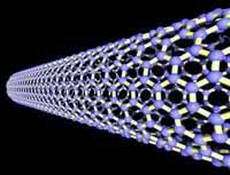November 29, 2005 feature
Converting Carbon Nanotubes into RNA-Degrading Nano-Enzymes

The researchers and scientists at Rensselaer Polytechnic Institute and the University of Illinois, Urbana-Champaign have achieved a major breakthrough in utilizing nanotechnology. The team of researchers has been successful in combining a DNA-based enzyme with a carbon nanotube; they have successfully combined the DNA based enzyme and have converting Carbon Nanotubes into RNA-Degrading Nano-Enzymes. Thus they have created a nanoscale device capable of degrading specific sequences of RNA.
Such a device is capable of providing a novel approach to treat cancer. This device would be quite a beneficial instrument in cancer therapy as it would be enabling researchers to block a cancer cell's production of proteins needed to maintain a cancerous state.
Carbon nanotubes were at one time the sole province of material scientists and structural engineers. The application of nanotechnology has diversified the use of carbon nanotubes and they have now captured the attention of cancer researchers because of the ability of these nanoscale structures to cross the cell membrane, ferrying in proteins and other potential imaging and drug molecules.
A team headed by Jonathan Dordick, Ph.D., is attempting to use this capability to
deliver so-called DNAzymes to the cells. DNAzymes are short stretches of single-stranded DNA that break down specific sequences of RNA. The cells use these specific sequences of RNA and thereafter the cells use it to convert information stored in their chromosomes into the myriad proteins they need to thrive.
Numerous experiments have shown that breaking down a specific RNA, and thus turning off production of the corresponding protein, can have a therapeutically beneficial result.
As reported in Journal of the American Chemical Society, the researchers delineate and describe a five-step process for attaching DNAzymes to the surface of a carbon nanotube. The resulting DNAzyme-nanotube hybrid retains all of the enzymatic activity of the DNAzymes without the use of any special reaction conditions, that is, the hybrid would have a good chance of degrading RNA under the conditions found within a cell.
It is quite interesting to note that this hybrid may also be able to simultaneously transport other molecules into cells by packing this secondary payload into the hollow core of the nanotubes. These highly active and stable DNAzyme, which are essentially carbon nanotube hybrids, are major breakthrough into the application of nanotechnology for treatment of cancer.
Dr. Bikram Lamba, an international management consultant, is Chairman & Managing Director of Tormacon Limited- a multi-disciplinary consultancy organization. He can be contacted at 905 848 4205. Email: torconsult@rogers.com, site: www.torconsult.com .
by Dr. Bikram Lamba, Copyright 2005 PhysOrg.com
















